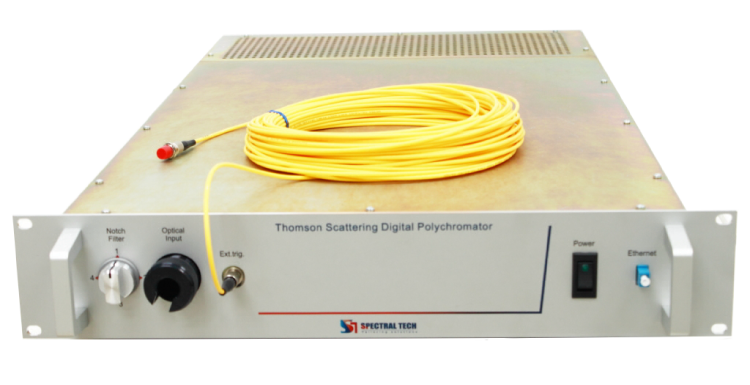Digital Polychromator

Spectrum analyzing system for Thomson scattering (TS) signals registration and processing (hereinafter referred to as “system ”) is intended for laboratory plasma investigation by the Thomson scattering method in order to register local values of electrons temperature and density in plasma with detailed temporal and spatial resolution, as well as for recording, storing and processing the obtained data. Application fields: scientific research.
Detailed description
Technical specifications
| Characteristic | Value |
| Spectral range λΔ, nm | 1064-920 (may vary on demand) |
| Basic wavelength of the probe laser λ (YAG), nm | 1064 |
| Repetition rate of measured signals, Hz | 100 – 3000 |
| Number of pulses recorded during discharge, pulses/discharge, not more than | 1000 (may vary on demand) |
| Weight of the system (without optical fiber bundles and electrical cables), kg, not more than | 550 |
| Weight of the equipped cubicle, kg, not more than 500 Power consumption, V∙А, not more than | 3800 |
| Power supply | |
| Voltage, V | 220±22 |
| Frequency, Hz | 50±1 |
| Reliability | |
| Mean-Time-To-Failure, h, not less than | 10000 |
| Average service life, y, not less than | 5 |
| Average recovery time, h, not less than | 4 |
| Filter polychromator | |
| Photodetector | Avalanche photodiode (APD) |
| Number of spectral channels | 6 |
| Spectral ranges of the channels, nm | 1060-1055, 1055-1045, 1045-1025, 1025-985, 985-920, 1063-1065, (may vary on demand) |
| Scattering signal digital recorder | |
| Sample rate, GSPS | 5 |
| Resolution, bit | 12 |
| Background radiation digital recorder | |
| Sample rate, KSPS | 10 |
| Resolution, bit | 12 |
| Dimensions (LхWхH), mm, not more than | 88х482х842 |
| Weight, kg, not more than | 23 |
| Number of polychromators in the rack, pcs | 10 (may vary on demand) |
| Power consumption, V∙А, not more than | 100 |
| Synchronization unit | |
| Electrical signal input / output | |
| Voltage | 5 |
| Pulse duration, ns | 50 |
| Laser pulse shape detector | |
| Bandwidth, MHz | 300 |
| Sample rate, GSPS | 5 |
| Resolution, bit | 12 |
| Dimensions (LхWхH), mm, not more than | 88х482х385 |
| Weight, kg, not more than | 7 |
| Power consumption, V∙А, not more than | 35 |
| Data processing and storage unit (industrial PC) | |
| RAM size, Gb | 16 |
| Hard drive space, Tb | 3 |
| Number of hard drives | 4 |
| Cache/boot solid state drive space, Gb | 120 |
| Number of processor cores | 4 |
| Cache size, Mb | 8 |
| CPU, GHz | 2,9 |
| Number of 10-Gigabit network connectors | 2 |
| Dimensions (LхWхH), mm, not more than | 175х482х570 |
| Weight, kg, not more than | 20 |
| Power consumption, V∙А, not more than | 700 |
| Equipment cubicle | |
| Dimensions (LхWхH), mm, not more than | 2145х800х1000 |
| Type | 19-inch rack |
| UPS power consumption, V∙А, not more than | 2000 |
| Weight (without equipment), kg, not more than | 250 |
| Optical trigger unit | |
| Laser attenuation | Combination of light filters and / or attenuator |
| Parameters of attenuated laser radiation | |
| Energy, mJ, not less than | 0,5 |
| Divergence, rad | 2 * 10 -4 |
| Dimensions (LхWхH), mm, not more than | 52х52х167 |
| Weight, kg, not more than | 1 |
#Operating conditions
| Characteristics | Value |
| Ambient air temperature, °C | 15…28 |
| Ambient pressure, kPa | 19…23 |
| Relative humidity at 21°C, not more than, % | 84,0…106,7 |
| Relative dispersion, nm/mm | 60 |
| Vibrations and shocks | no |
General Principles of Operation
The system operation is based on analysis of electron component of laboratory plasma by the method of Thomson scattering of laser radiation. Scattered laser radiation is collected by the collection lens, the focal surface of which comprises input ends of optical fiber bundles, distributing radiation across the filter polychromators (hereinafter - “polychromator”). Each polychromator measures electron temperature and density at one spatial point. Electron temperature is determined on the basis of scattered radiation spectrum analysis. Density value is determined by intensity of the recorded scattering signals. Scattering signals registration is carried out by a small number of spectral channels (up to 6). Each spectral channel is equipped with transimpedance amplifier with avalanche photodiodes (APD). The used amplifier comprises two outputs: high-frequency (for measuring scattering signals) and low-frequency (for calibration), capable to measure quasi-permanent signals. The signals are digitized by the ADC embedded in the polychromator.
Prior to measurements, the system should be calibrated. Spectral and absolute calibrations should be carried out for the Thomson scattering diagnostics. Spectral calibration, the essence of which is to estimate relative sensitivity of spectral channels, is necessary for electron temperature determination. A set of calibration equipment supplied with the system is used for spectral calibration. Absolute calibration is necessary toSpectrum analyzing system for Thomson scattering signals registration and processing determine electrons density; its purpose is to determine the coefficient of correspondence between the number of scattered photons and magnitude of the detected signal for each spectrometer. Absolute calibration is performed using the Raman scattering method.